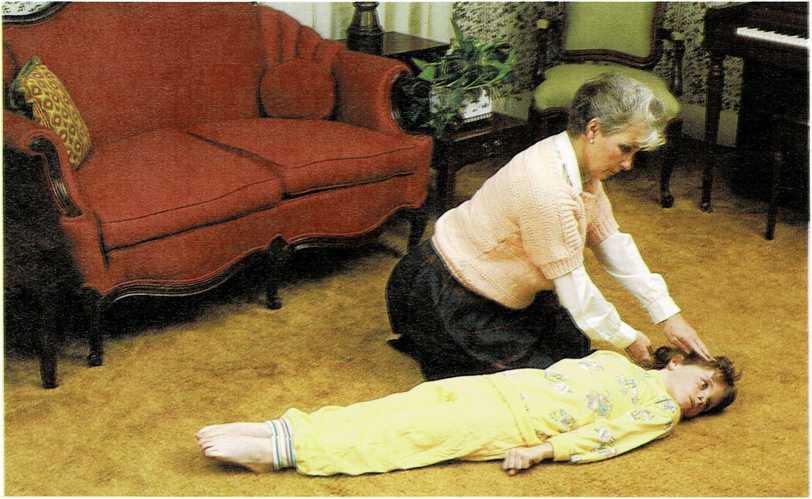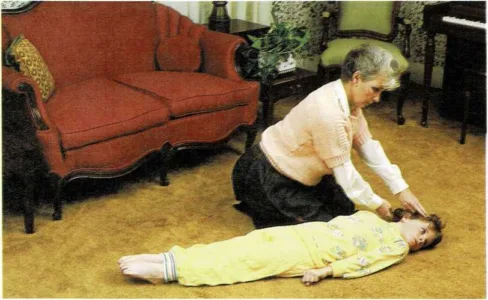Convulsions – Coughing
Convulsions (seizures) are involuntary contractions of muscles.
During a convulsion, a child’s muscles may jerk or twitch, and the child
may lose consciousness. Eyes may roll, stay open, or almost close, and
the child may have brief spells of staring into space. Teeth may be
clenched. The child may become rigid, with the neck arched, arms and
legs stiff, and toes pointing. Sometimes during a convulsion, the child
may urinate involuntarily or have a bowel movement. Although convulsions
are frightening to watch, they usually are not dangerous.
If your child has a convulsion, try to remain calm and reassuring.
Unless the child is in a dangerous place, let the child stay in the
position in which he or she falls—on back, side, or stomach. Turn the
child’s head to one side to prevent choking if the child vomits. The
convulsion usually stops within a few minutes. After the convulsion, the
child generally sleeps deeply for a while.
If your child has a convulsion for the first time, it is important to
call the doctor as soon as possible. Although fevers are the most common
cause of convulsions, infectious diseases could also be the cause.
Convulsions are brought on by brain disturbances. The most common cause
of convulsions for children between 1 and 3 is high

Although convulsions usually are not dangerous, there is always a
chance of self-injury during a convulsion. Turn the head to one side
to keep the child from choking, Remove nearby objects. Do not move the
child unless the location is hazardous. Call a doctor as soon as
possible.
fever. If high fever tends to bring on convulsions in your child, the
doctor may prescribe daily doses of an anticonvulsant medicine for a
couple of years. You should also take precautions whenever your child
has a high fever (102° F.; 39° C) by giving the child appropriate doses
of acetaminophen or other drugs your doctor may prescribe for fever, as
well as a sponge bath in lukewarm water.
Convulsions may also occur in connection with diseases causing unusually
low blood sugar or unusually low levels of calcium in the blood. In
diseases such as tetanus (lockjaw) or infections of the brain, such as
meningitis, convulsions are often frequent and severe. Convulsions may
occur after birth injuries or after brain injuries resulting from
accidents. Epilepsy is the name given to convulsions that occur
repeatedly without any fever or disease, [m.g.]
See also Epilepsy; Fever; Head injuries
Cot death. See Crib death
Coughing usually indicates that something is irritating the
breathing passages and that the body should be rid of it. Some of the
most common causes of coughing are the following:
Respiratory infections such as bronchitis, the common cold, croup,
pneumonia, sinusitis, and whooping coughAllergies such as asthma and hay fever
Accidentally breathing small objects such as coins, tiny toys,
safety pins, beads, or small food particles into the windpipe or
lungsAccidentally breathing chemical substances into the windpipe or
lungs
Chronic coughing may be caused by cystic fibrosis or reactive airway
disease (asthma). Occasionally, a child develops a cough habit.
The way you treat a cough depends largely on its cause. Consult the
doctor to determine the cause. The doctor may advise chest X rays, blood
tests, a sweat chloride test for cystic fibrosis, and allergy tests.
Usually, a child’s coughing should not be suppressed. It is the normal
way to get rid
of irritating material in the respiratory system. But if coughing tires
your child or interferes with sleep, the doctor may prescribe a cough
medicine for the child or tell you to give the child cough drops. Never
give cough medicine to a child unless your doctor prescribes it.
Here are some other steps your doctor may take to relieve your child’s
coughing: ■ In case of a bacterial respiratory infection, the doctor may
prescribe antibiotics and advise you to increase the humidity in the
child’s room. Moistened air makes breathing easier for the child.
In case of nasal allergies, the doctor may prescribe antihistamine
drugs to prevent or lessen allergic reactions.If a foreign object has been breathed into the windpipe or lungs,
the object may have to be removed surgically.
See also Asthma; Bronchitis; Colds; Croup; Cystic fibrosis; Hay
fever; Humidifying; Measles; Pneumonia; Sinusitis; Swallowed objects;
Tuberculosis; Whooping cough

